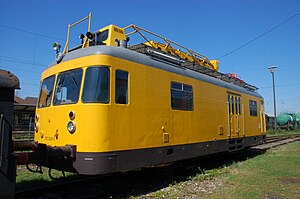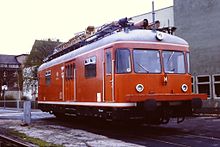DB class 701
| DB class 701/702 | |
|---|---|
|
Tower car 701 in the Bavarian Railway Museum in Nördlingen
|
|
| Numbering: | 701 001-170 with gaps; 702 (new): 702 042, 049, 050, 055, 056, 115, 123-125, 129, 131-138, 148-150, 163, 164 |
| Number: | 701: 104 702: 20 |
| Manufacturer: | MBB, Rathgeber, Uerdingen, WMD |
| Year of construction (s): | 1955-1974 |
| Axis formula : | 701: AA 702: A1 |
| Genre : | Auxiliary vehicle |
| Gauge : | 1435 mm ( standard gauge ) |
| Length over buffers: | 13,950 mm |
| Empty mass: | approx. 23 t |
| Service mass: | 701: 24.6 702: 21.8 t max. 28 t total weight |
| Top speed: | 90 km / h |
| Installed capacity: | 701: 2 × 110 kW 702: 110 kW |
| Hourly output : | 2 × 150 hp |
| Acceleration: | moderate, therefore only max. 75 t trailer load |
| Driving wheel diameter: | 980 to 940 mm |
| Impeller diameter: | 980 mm |
| Motor type: | Bussing U10 |
| Motor type: | Inline six-cylinder lying |
| Rated speed: | 2600rpm |
| Power transmission: | electromechanical |
| Tank capacity: | 2 × 400 l |
| Power system : | 24 V on-board voltage, special design +12 V and −12 V with center tap, therefore 2 generators and 4 batteries required per machine line. |
| Number of traction motors: | 701: 2 702: 1 2 × Büssing U10 lying |
| Drive: | 2 × Büssing U10 with up to 3L consumption per kilometer |
| Translation levels: | 6 gears with electr. Clutch & Hydrostatic Converter |
| Type of speed switch: | 6 gears, plus lower red dot: with gear oiling by engine,
Upper red dot: oiling by axle drive. Electric gearbox Voith 6E75-S, axle reversing gear from Gmeinder - identical in construction to VT95 to VT98. Motor oil is also poured into the gearboxes and axles. Summer oil: single grade oil HD30. Hydraulically driven fans must not get bio oil, otherwise the carrion drips like an oil sardine and fans only run at reduced speed! Small screw coupling with 1500 t predetermined breaking point instead of the usual 3000 t. When coupling with other control vehicles, only the weaker TVT / VT98 coupling may be hooked, the stronger control coupling remains unused! |
| Brake: | takes place via pressure intensifier, TVT cannot be adjusted in the train with the brakes! |
| Train control : | i60, later i90 |
| Train heating: | nothing |
| Control: | 6 gears electrically via rear derailleur, identical to VT98 |
| Coupling type: | Screw coupling |
| Particularities: | Due to the pressure intensifier, it must not run with the brakes in the trains, the axle reversing gear must be locked in the middle with a spring bolt!
Due to the weaker screw coupling, TVTs can only be carried in trains at the end of the train without air. |
| Preheat engines below +5 ° C with Webasto to reduce wear and avoid uncontrolled burns (pistons tilt and destroy cylinder liners)! | |
The series 701 and 702 are a series of railway service vehicles of the Deutsche Bundesbahn set as auxiliary vehicles.
In the 1950s, the network of the Deutsche Bundesbahn was increasingly electrified. This created a need for vehicles to install and maintain the contact line . That is why the Deutsche Bundesbahn procured a total of 167 modern maintenance vehicles, mostly twin-engine, for this purpose. The VT 55 (from 1968 series 701) was based on the VT 98 rail bus (from 1968 series 798 ). The manufacturer was Waggon- und Maschinenbau GmbH Donauwörth or its successor MBB .
Car body and interior
The railcars had a welded steel box structure . Between the driver's cabs there is a 26 m 2 lounge with a workshop. Shelves, a workbench as well as seating and washing facilities are installed there, and access to the pulpit for monitoring the contact line is also located there.
Roof equipment
On the roof there is a pantograph for earthing and testing the catenary for 2 × 4 50 mm laterally from the middle position and height from 4800 mm to 5500 mm. The roof is almost completely covered by a hydraulically liftable and swiveling work platform . The working platform can be loaded with up to 300 kilograms. It can be hydraulically extended up to 5.14 m above the top of the rail and swiveled up to 3.85 m from the track axis. An observation pulpit and searchlights were also installed on the roof.
Some 701s of DB Netz Maintenance have been converted to overhead line test vehicles (diagnosis VT) and instead of the working platform they have a second pantograph on the roof.
Design differences
The four single-engine railcars , which were designated as the 702 series from 1968, received a second engine in 1972 and were re-designated as 701. From 1973 onwards, 23 vehicles were equipped with a hydrodynamic brake and a magnetic rail brake for use on steep stretches ; these were then given the designation 702, which had become vacant.
Diagnostic tower railcar
Several tower cars, including 702 148, 163 and 701 165, 167 to 168, were converted to diagnostic tower cars (DVT). Among other things, they received a second pantograph instead of the working platform. They are used to inspect the overhead contact line, but due to the low top speed of 90 km / h they should be taken out of service promptly.
Network maintenance 702.2
Web links
Individual evidence
- ^ Michael Dostal: DB vehicles: locomotives and railcars of the DB AG . GeraMond-Verlag, Munich 2002, ISBN 3-7654-7175-5 , p. 172
- ^ The rail buses of the DB - VT 95/98. EK-Special 16. EK Verlag, Freiburg 1990
- ^ DB Vehicle Lexicon. EK-Special 30. EK Verlag, Freiburg 1993
- ↑ Ralf Roman Rossberg : Checking, testing, trying out, monitoring. In: eisenbahn-magazin 7/2012, p. 38


